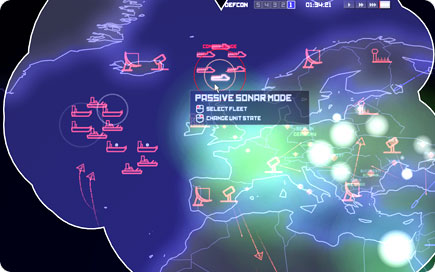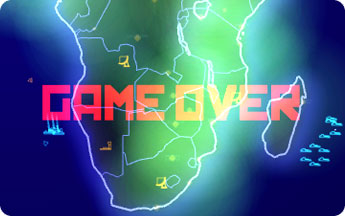- Site: DEFCON
- Publisher: Ambrosia Software
- Developer: Introversion Software
- Genre: Strategy
By Brad Cook
Just like that, San Francisco was hit. And then Phoenix. Dallas. Houston. A million dead in one city, 1.3 million gone in another. Counter-strikes took to the skies, sending wave after wave of missiles toward Glasgow, Paris, Lisbon, and Marseille.

A fleet of battleships off the East coast of the United States found itself under attack by a group of enemy submarines. Two opposing aircraft carrier fleets clashed nearby, their planes buzzing around the enormous ships in furious dogfights. Submarines around the globe began unleashing their nukes.
The global map lit up with the white-hot flashes of nuclear detonations. After a time, the beehive of activity ceased, the survivors simply trying to live amid the aftermath.
This is the part of the story, such as in the movie War Games, where we learn that there are no winners in nuclear war, only losers. DEFCON, however, plays the matter tongue-in-cheek, with the tagline “everybody dies” and a scoring system that depends on the number of civilians who live and perish. The goal is not to avoid World War III, but to come out of it with as few casualties as possible.
Simpler Times
Let’s take a step back in time, to that brief interlude of peace, when DEFCON (DEFense CONdition) stood at 5 and you merely had to worry about unit placement. Your radar dishes gave you ample coverage of an area as far as possible outside your territory, and you placed your missile silos and airbases with judicious care. You deployed your fleets of battleships, aircraft carriers, and submarines, maneuvering them into position for the battle to come.
At DEFCON 4, your radar coverage began relaying information about the enemy units that strayed within their range. Once the world reached DEFCON 3, you could no longer place your units, but you realized the fruits of your naval strategies, engaging enemy ships in combat. Your aircraft carriers launched their planes while your submarines destroyed enemy battleships with cold precision.
DEFCON 2 arrived and worldwide hostilities increased. You know what happened at DEFCON 1. A victory timer soon began counting down the final 45 minutes of the game, giving each player a final opportunity to inflict casualties on his opponents. Several last-minute strikes gave you just enough points to eke out a victory. You were wise to save your best for last.
The End of the World as We Know It
Up to six players can join the action, consisting of you against AI opponents or you versus others across a LAN (local area network) or the Internet. You can also set up the game to allow up to three spectators to watch the carnage. There are seven modes to choose from:
- Default: The standard game.
- Office: DEFCON runs in a window with no sound. Press the Escape key twice in quick succession to minimize the window if your boss strolls by.
- Big World: The world is twice as large, but each unit is half the normal size, with radar coverage, weapons range, and speed also halved.
- Speed DEFCON: The game runs at the fastest of the four available speeds, lasting no longer than 15 minutes. No pausing allowed.
- Diplomacy: All players begin as members of one alliance, which means they all share radar coverage and can see everything their opponents are doing, at least until the coalition breaks up.
- Tournament: Players get random territories, and spectators can’t communicate with them.
- Custom: Set up your own contest from the Advanced Options menu.
You can also select one of three scoring methods: Default, in which you get two points for each million enemies killed (known as a “megadeath”) but lose one point for each million you don’t protect in your territory; Genocide, where you simply get one point per megadeath; and Survivor, which starts at 100 points and subtracts one point for each million lost in your territory.
You don’t have to fight with each player in the game, however: You can always create alliances with others, letting each of you know where other players’ units are and granting the right to fly aircraft over each other’s territory without being shot down. Of course, you can dissolve an alliance any time you want, which comes in handy when you’ve figured out another player’s weaknesses and decide to exploit them.
Then again, they can do the same to you. As they say, all’s fair in love and war, and when it comes to thermonuclear war, well, all bets are off.
Game Hardware
Check out our systems for your best gaming experience.

Shall We Play a Game? The world lights up.

Watch Your Borders. The territory view shows you the scope of your control.

Take to the Skies. Bombers deliver their deadly payloads.

Seeing Through the Shroud. Your radar stations lift the fog of war, as do your planes and ships.
If you liked this game, check out:
- Age of Empires III
- Civilization IV: Warlords
- Command & Conquer Generals: Zero Hour
- Darwinia
- Pangea Arcade
- SketchFighter 4000 Alpha
System Requirements:
- Mac OS X version 10.3.9
- Intel or PowerPC G4 processor
Tips and Tricks

- Place your missile silos near your cities. They begin the game in air defense mode, which means they’ll attempt to shoot down enemy planes, as well as missiles, assuming you don’t switch them to ICBM mode.
- Putting your silos in ICBM mode leaves nearby cities defenseless, so wait until your opponents start launching missiles before you attempt to hit their cities. And don’t switch your silos all at once, or you’ll wind up leaving your cities vulnerable.
- Keep your submarines together, since they can move close to your opponent’s coast and then launch nukes at her cities. But you should mix and match battleships and carriers, since carriers can destroy submarines but battleships can’t. However, carriers are more easily destroyed than battleships.
- Don’t neglect your airbases. They can launch fighters as well as bombers that carry nukes. The fighters regenerate, so keep checking your airbases if you’re contending with lots of ships off your coast, or incoming bombers carrying nukes.
- Place radar dishes at the extreme edges of your territory, to give yourself maximum coverage, and string them together so that their range just barely overlaps, thus blanketing as much area as possible.
- Since your airbases can regenerate fighters, treat them like disposable units. Employ large groups of them to scout enemy territory, and send several of them ahead of your nuclear missiles to distract your opponent’s anti-aircraft defenses.
- Bombers without nukes won’t do anything to a city, but they can still attack ships.
- You can mod DEFCON to your heart’s content. Learn more on the Introversion forums, in the “MOD PROJECTS” area.
